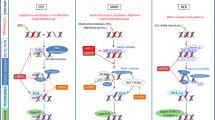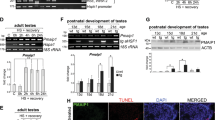Abstract
The cellular-stress response can mediate cellular protection through expression of heat-shock protein (Hsp) 70, which can interfere with the process of apoptotic cell death. Stress-induced apoptosis proceeds through a defined biochemical process that involves cytochrome c, Apaf-1 and caspase proteases. Here we show, using a cell-free system, that Hsp70 prevents cytochrome c/dATP-mediated caspase activation, but allows the formation of Apaf-1 oligomers. Hsp70 binds to Apaf-1 but not to procaspase-9, and prevents recruitment of caspases to the apoptosome complex. Hsp70 therefore suppresses apoptosis by directly associating with Apaf-1 and blocking the assembly of a functional apoptosome.
This is a preview of subscription content, access via your institution
Access options
Subscribe to this journal
Receive 12 print issues and online access
$209.00 per year
only $17.42 per issue
Buy this article
- Purchase on Springer Link
- Instant access to full article PDF
Prices may be subject to local taxes which are calculated during checkout







Similar content being viewed by others
References
Wolf, B. & Green, D. R. Suicidal tendencies: apoptotic cell death by caspase family proteinases. J. Biol. Chem. 274, 20049–20052 (1999).
Liu, X., Kim, C. N., Yang, J., Jemmerson, R. & Wang, X. Induction of apoptotic program in cell-free extracts: requirement for dATP and cytochrome c. Cell 86, 147–157 (1996).
Zou, H., Henzel, W. J., Liu, X., Lutschg, A. & Wang, X. Apaf-1, a human protein homologous to C. elegans CED-4, participates in cytochrome c-dependent activation of caspase-3. Cell 90, 405–413 (1997).
Srinivasula, S. M., Ahmad, M., Fernandes-Alnemri, T. & Alnemri, E. S. Autoactivation of procaspase-9 by Apaf-1-mediated oligomerization. Mol. Cell 1, 949–957 (1998).
Zou, H., Li, Y., Liu, X. & Wang, X. An APAF-1 cytochrome c multimeric complex is a functional apoptosome that activates procaspase-9. J. Biol. Chem. 274, 11549–11556 (1999).
Cain, K. et al. Apaf-1 oligomerizes into biologically active ~700-kDa and inactive ~1.4-MDa apoptosome complexes. J. Biol. Chem. 275, 6067–6070 (2000).
Cain, K., Brown, D. G., Langlais, C. & Cohen, G. M. Caspase activation involves the formation of the aposome, a large (~700 kDa) caspase-activating complex. J. Biol. Chem. 274, 22686–22692 (1999).
Hu, Y., Benedict, M. A., Ding, L. & Nunez, G. Role of cytochrome c and dATP/ATP hydrolysis in Apaf-1-mediated caspase- 9 activation and apoptosis. EMBO J. 18, 3586–3595 (1999).
Lindquist, S. & Craig, E. A. The heat-shock proteins. Annu. Rev. Genet. 22, 631–677 (1988).
Gething, M. J. & Sambrook, J. Protein folding in the cell. Nature 355, 33–45 (1992).
Parsell, D. A., Taulien, J. & Lindquist, S. The role of heat-shock proteins in thermotolerance. Phil. Trans. R. Soc. Lond. B 339, 279–285 (1993).
Parsell, D. A. & Lindquist, S. The function of heat-shock proteins in stress tolerance: degradation and reactivation of damaged proteins. Annu. Rev. Genet. 27, 437–496 (1993).
Milarski, K. L. & Morimoto, R. I. Expression of human HSP70 during the synthetic phase of the cell cycle. Proc. Natl Acad. Sci. USA 83, 9517–9521 (1986).
Samali, A. & Orrenius, S. Heat shock proteins: regulators of stress response and apoptosis. Cell Stress Chaperones 3, 228–236 (1998).
Jaattela, M. Escaping cell death: survival proteins in cancer. Exp. Cell Res. 248, 30–43 (1999).
Freeman, B. C., Myers, M. P., Schumacher, R. & Morimoto, R. I. Identification of a regulatory motif in Hsp70 that affects ATPase activity, substrate binding and interaction with HDJ-1. EMBO J. 14, 2281–2292 (1995).
Kluck, R. M., Bossy-Wetzel, E., Green, D. R. & Newmeyer, D. D. The release of cytochrome c from mitochondria: a primary site for Bcl-2 regulation of apoptosis. Science 275, 1132–1136 (1997).
Li, P. et al. Cytochrome c and dATP-dependent formation of Apaf-1/caspase-9 complex initiates an apoptotic protease cascade. Cell 91, 479–489 (1997).
Stennicke, H. R. et al. Caspase-9 can be activated without proteolytic processing. J. Biol. Chem. 274, 8359–8362 (1999).
Benedict, M. A., Hu, Y., Inohara, N. & Nunez, G. Expression and functional analysis of Apaf-1 isoforms. Extra WD-40 repeat is required for cytochrome c binding and regulated activation of procaspase-9. J. Biol. Chem. 275, 8461–8468 (2000).
Hahn, G. M. & Li, G. C. Thermotolerance and heat shock proteins in mammalian cells. Radiat. Res. 92, 452–457 (1982).
Mosser, D. D. & Martin, L. H. Induced thermotolerance to apoptosis in a human T lymphocyte cell line. J. Cell Physiol. 151, 561–570 (1992).
Mosser, D. D., Caron, A. W., Bourget, L., Denis-Larose, C. & Massie, B. Role of the human heat shock protein hsp70 in protection against stress-induced apoptosis. Mol. Cell Biol. 17, 5317–5327 (1997).
Samali, A. & Cotter, T. G. Heat shock proteins increase resistance to apoptosis. Exp. Cell Res. 223, 163–170 (1996).
Simon, M. M. et al. Heat shock protein 70 overexpression affects the response to ultraviolet light in murine fibroblasts. Evidence for increased cell viability and suppression of cytokine release. J. Clin. Invest. 95, 926–933 (1995).
Jaattela, M., Wissing, D., Bauer, P. A. & Li, G. C. Major heat shock protein hsp70 protects tumor cells from tumor necrosis factor cytotoxicity. EMBO J. 11, 3507–3512 (1992).
Liossis, S. N., Ding, X. Z., Kiang, J. G. & Tsokos, G. C. Overexpression of the heat shock protein 70 enhances the TCR/CD 3- and Fas/Apo-1/CD 95-mediated apoptotic cell death in Jurkat T cells. J. Immunol. 158, 5668–5675 (1997).
Creagh, E. M. & Cotter, T. G. Selective protection by hsp70 against cytotoxic drug-, but not Fas- induced T-cell apoptosis. Immunology 97, 36–44 (1999).
Mehlen, P., Schulze-Osthoff, K. & Arrigo, A. P. Small stress proteins as novel regulators of apoptosis. Heat shock protein 27 blocks Fas/APO-1- and staurosporine-induced cell death. J. Biol. Chem. 271, 16510–16514 (1996).
Li, C-Y., Lee, J-S., Ko, Y-G., Kim, J-I., & Seo, J-S. Hsp70 inhibits apoptosis downstream of cytochrome c release and upstream of caspase-3 activation. J. Biol. Chem. (in the press).
Jaattela, M., Wissing, D., Kokholm, K., Kallunki, T. & Egeblad, M. Hsp70 exerts its anti-apoptotic function downstream of caspase-3-like proteases. EMBO J. 17, 6124–6134 (1998).
Gabai, V. L. et al. Hsp70 prevents activation of stress kinases. A novel pathway of cellular thermotolerance. J. Biol. Chem. 272, 18033–18037 (1997).
Patriarca, E. J. & Maresca, B. Acquired thermotolerance following heat shock protein synthesis prevents impairment of mitochondrial ATPase activity at elevated temperatures in Saccharomyces cerevisiae. Exp. Cell. Res. 190, 57–64 (1990).
Polla, B. S. et al. Mitochondria are selective targets for the protective effects of heat shock against oxidative injury. Proc. Natl Acad. Sci. USA 93, 6458–6463 (1996).
Evan, G.I. et al. Induction of apoptosis in fibroblasts by c-myc protein. Cell 69, 119–128 (1992).
Juin, P., Hueber, A. O., Littlewood, T. & Evan, G. c-Myc-induced sensitization to apoptosis is mediated through cytochrome c release. Genes Dev. 13, 1367–1381 (1999).
Cecconi, F., Alvarez-Bolado, G., Meyer, B. I., Roth, K. A. & Gruss, P. Apaf-1 (CED-4 homolog) regulates programmed cell death in mammalian development. Cell 94, 727–737 (1998).
Yoshida, H. et al. Apaf-1 is required for mitochondrial pathways of apoptosis and brain development. Cell 94, 739–750 (1998).
Soengas, M. S. et al. Apaf-1 and caspase-9 in p53-dependent apoptosis and tumor inhibition. Science 284, 156–159 (1999).
Xanthoudakis, S. et al. Hsp60 accelerates the maturation of pro-caspase-3 by upstream activator proteases during apoptosis. EMBO J. 18, 2049–2056 (1999).
Wolf, B., Schuler, M., Echeverri, F. & Green, D. R. Caspase-3 is the primary activator of apoptotic DNA fragmentation via DFF 45/ICAD inactivation. J. Biol. Chem. 274, 30651–30656 (1999).
Rodriguez, J. & Lazebnik, Y. Caspase-9 and APAF-1 form an active holoenzyme. Genes Dev. 13, 3179–3184 (1999).
Wolf, B.B. et al. Calpain functions in a caspase-independent manner to promote apoptosis-like events during platelet activation. Blood 94, 1683–1692 (1999).
Acknowledgements
We thank G. Nunez and Y. Lazebnik for reagents, and C. Langlais and D. Brown for technical assistance. This work was supported by grants AI40646 and AI47891 from the National Institutes of Health.
Correspondence and requests for materials should be addressed to D.R.G.
Author information
Authors and Affiliations
Rights and permissions
About this article
Cite this article
Beere, H., Wolf, B., Cain, K. et al. Heat-shock protein 70 inhibits apoptosis by preventing recruitment of procaspase-9 to the Apaf-1 apoptosome. Nat Cell Biol 2, 469–475 (2000). https://doi.org/10.1038/35019501
Received:
Revised:
Accepted:
Published:
Issue Date:
DOI: https://doi.org/10.1038/35019501
This article is cited by
-
Insights into the molecular mechanisms underlying the different heat tolerance of the scleractinian coral Pavona decussata
Coral Reefs (2024)
-
Capsaicin binds the N-terminus of Hsp90, induces lysosomal degradation of Hsp70, and enhances the anti-tumor effects of 17-AAG (Tanespimycin)
Scientific Reports (2023)
-
Cannabidiol-induced crosstalk of apoptosis and macroautophagy in colorectal cancer cells involves p53 and Hsp70
Cell Death Discovery (2023)
-
Role of heat shock proteins in oncogenesis and strategy for treating cancers using Drosophila model
Proceedings of the Indian National Science Academy (2023)
-
Transcriptome and histopathology analyses of the gills of Eriocheir sinensis provide novel insights into the molecular mechanism of Pb stress
Aquaculture International (2023)



